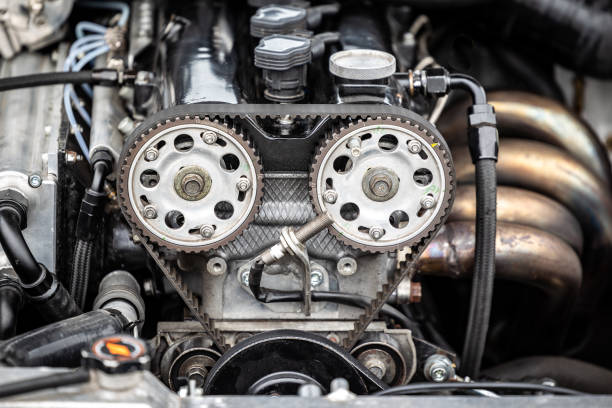If you’re diving into car maintenance or facing an engine repair, you’ve probably come across the terms timing belt and timing chain. Both play a crucial role in keeping your engine running smoothly, but they’re not the same—and knowing which one your car has can help you stay on top of maintenance and avoid costly damage.
So, how do you know if your car has a timing belt or a timing chain? Let’s break it down.
What’s the Difference Between a Timing Belt and a Timing Chain?
Timing Belt:
- Made of rubber with high-tensile fibers inside
- Quieter and lighter than a chain
- Needs to be replaced regularly (usually every 60,000 to 100,000 miles)
- Located outside the engine and often covered by plastic housing
Timing Chain:
- Made of metal
- Heavier, more durable, and often lasts the lifetime of the engine
- Requires less frequent replacement (unless it stretches or fails)
- Located inside the engine and lubricated by engine oil
Why Timing Matters
Both the belt and the chain serve the same purpose: to synchronize the rotation of the crankshaft and camshaft(s). This timing ensures that your engine’s valves open and close at the correct intervals during the combustion cycle.
If the timing is off—whether due to a worn belt, stretched chain, or sudden failure—it can lead to:
- Poor engine performance
- Misfires
- Valve and piston damage (in interference engines)
- Complete engine failure in severe cases
How to Know Which One Your Car Has
Here are a few easy ways to find out:
1. Check the Owner’s Manual
The fastest and most accurate method. Look under the maintenance schedule or engine specs section.
2. Search by Your Car’s Make, Model, and Year
You can look up your vehicle online using terms like:
“2016 Honda Accord timing belt or chain”
3. Ask a Mechanic or Dealer
Your local dealership or trusted mechanic can give you a definitive answer quickly.
4. Look Under the Hood (If You’re Confident)
- Rubber belt with plastic covers = Timing belt
- No visible belt (metal chain inside engine) = Timing chain
Common Brands and What They Use
Here’s a quick reference for popular car brands:
Timing Belt (typically used in older models or smaller engines):
- Honda (older Civic, Accord, CR-V)
- Toyota (older Corolla, Camry)
- Subaru (some models)
- Hyundai/Kia (many 4-cylinder engines)
Timing Chain (more common in modern vehicles):
- BMW
- Mercedes-Benz
- Nissan
- GM (Chevrolet, GMC, Cadillac)
- Ford (most newer models)
- Toyota & Honda (newer V6 and turbo engines)
Note: Manufacturers sometimes switch between belts and chains depending on the engine size or model year.
When to Replace a Timing Belt
If your car has a timing belt, replacement is critical. Most manufacturers recommend replacing it around 60,000 to 100,000 miles. Ignoring this can result in belt failure, which in an interference engine, can cause serious damage.
Signs your timing belt might be failing:
- Ticking noise from the engine
- Engine misfires
- Rough idling
- Oil leaks near the timing cover
- Engine won’t start
What About Timing Chains?
Timing chains are designed to last longer—often over 150,000 miles—but they aren’t immune to problems. They can stretch or wear over time, especially with poor maintenance or irregular oil changes.
Warning signs of a failing timing chain:
- Rattling noise on startup or idle
- Check engine light
- Poor performance or engine misfires
- Metal shavings in the oil
Cost to Replace Timing Belts vs. Chains
Timing Belt Replacement:
- $400 to $900 (depending on the vehicle)
- Often includes replacing tensioners and water pump
Timing Chain Replacement:
- $1,000 to $2,500+
- Labor-intensive because it’s inside the engine
That’s why regular maintenance—especially oil changes—is key to keeping a timing chain in good condition.
FAQs
Can I visually confirm if I have a belt or chain?
Sometimes, yes. If you can see a black rubber belt with a cover, it’s likely a timing belt. Chains are internal and usually not visible without engine disassembly.
Which is better: timing belt or timing chain?
Neither is inherently better—they’re just different. Belts are quieter and cheaper to replace; chains last longer but are costlier when they do fail.
What happens if a timing belt breaks while driving?
If your car has an interference engine, a broken belt can cause the pistons and valves to collide, resulting in catastrophic engine damage.
Final Thoughts
Knowing whether your car has a timing belt or a timing chain isn’t just trivia—it’s essential for planning maintenance and avoiding major repairs. While belts require routine replacement, chains depend on regular oil changes to stay in good shape.
If you’re unsure, check your manual, search online, or ask your mechanic. Being proactive about your car’s timing system can save you thousands in repair costs and keep your vehicle running smoothly for years to come.








